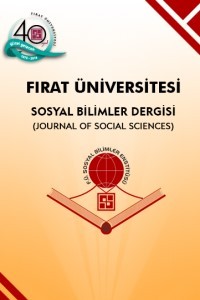Öz
Bu çalışmada marka kişiliği boyutlarının marka vefası boyutları üzerindeki etkileri araştırılmıştır. Bu amaçla Türkiye’de spor ayakkabı markaları içinde pazarda ilk üç sırayı alan Nike, New Balance ve Adidas markalı ayakkabıları kullanan tüketiciler üzerine bir araştırma yapılmıştır. Araştırma kapsamında 1-31 Temmuz 2019 tarihleri arasında, internetten 750 anket doldurulmuş ve her markadan 250 deneğe ulaşılmıştır. Araştırma modelinin analiz edilmesinde kısmi en küçük kareler yol analizi (PLS-SEM) kullanılmıştır. Veriler SmartPLS 3.2.8 istatistik programı kullanılarak analiz edilmiştir. Araştırma sonuçlarına göre, marka kişiliğinin alt boyutları olan; hümanizm, heyecan, statü geliştirme, profesyonellik ve zindeliğin marka vefasının alt boyutları olan; yardım etmeye hazır olma/affetme (performans), yardım etmeye hazır olma/affetme (fiyat), karşılıklı bağımlılık ve alternatiflerin küçülmesi üzerinde pozitif yönlü etkileri vardır.
Anahtar Kelimeler
Kaynakça
- Aaker, J. (1997). Dimension of brand personality. Journal of Marketing Research, 34 (3), 347-356.
- Albert, N. ve Merunka, D. (2013). The role of brand love in consumer-brand relationships. J. Consum. Mark, 30 (3), 258–266.
- Amine, A. (1998). Consumers' true brand loyalty: the central role of commitment. J. Strateg. Mark, 6 (4), 305–319.
- Anderson, R.E. (1973). Consumer dissatisfaction: the effect of disconfirmed expectancy on perceived product performance. J. Mark. Res., 10 (1), 38–44.
- Beatty, S.E., Homer, P. ve Kahle, L.R. (1988). The involvement - commitment model: theory and implications. J. Bus. Res., 6 (2), 149–167.
- Caprara, G. V., Barbaranelli, C. ve Guido, G. (2001). Brand personality: how to make the metaphor fit? Journal of Economic Psychology, 22 (3), 377–395.
- Carroll, B.A. ve Ahuvia, A.C. (2006). Some antecedents and outcomes of brand love. Mark. Lett,. 17 (2), 79–89.
- Cohen, R. J. (2014). Brand personification: introduction and overview. Psychology & Marketing, 31 (1), 1–30.
- Connell, P. M. (2013). The role of baseline physical similarity to humans in consumer responses to anthropomorphic animal images. Psychology & Marketing, 30, 461-468.
- Dall’ Olmo Riley, F. ve de Chernatony, L. (2000). The service brand as relationships builder. British Journal of Management, 11 (2), 137-150.
- Day, G.S. (1977). Diagnosing the product portfolio. J. Mark., 41 (2), 29–38.
- Eisend, M. ve Stokburger-Sauer, N.E. (2013). Brand personality: a meta-analytic review of antecedents and consequences. Marketing Letters, 24 (3), 205–216.
- Epley, N., Waytz, A. ve Cacioppo, J. T. (2007). On seeing human: a three-factor theory of anthropomorphism. Psychological Review, 114 (4), 864–886.
- Fleck, N., Michel, G. ve Zeitoun, V. (2014). Brand personification through the use of spokespeople: an exploratory study of ordinary employees, ceos, and celebrities featured in advertising. Psychology & Marketing, 31 (1), 84–92.
- Fornell, C. ve Larcker, D.F. (1981). Evaluating structural equation models with unobservable variables and measurement error. Journal of Marketing Research, 18 (1), 39-50.
- Freling, T. H. ve Forbes, L. P. (2005). An empirical analysis of the brand personality effect. Journal of Product and Brand Management, 14 (7), 404–413.
- Grace, D., Ross, M. ve King, C. (2018). Brand fidelity: a relationship maintenance perspective. J Brand Manag, 25, 577–590.
- Grace, D., Ross, M. ve King, C. (2020). Brand fidelity: scale development and validation. Journal of Retailing and Consumer Services, 52, 101908.
- Hair, J. F., Black, W. C., Babin, B. J., Anderson, R. E. ve Tatham, R. L. (2006). Multivariate data analysis. Upper Saddle River, NJ: Pearson Prentice Hall.
- Hair, J.F., Tomas, G., Hult, M., Ringle, C.M. ve Sarstedt, M. (2014). A primer on partial least square structural equations modeling (PLS-SEM). Los Angeles: Sage.
- Helgeson, J. G. ve Supphellen, M. (2004). A conceptual and measurement comparison of selfcongruity and brand personality. International Journal of Market Research, 46 (2), 205–233.
- Henseler, J., Ringle, C.M. ve Sarstedt, M. (2015). A new criterion for assessing discriminant validity in varience-based structural equation modelling. Journal of the Academy of Marketing Science, 43, 115-135.
- Keller, K.L. (1993). Conceptualizing, measuring and managing consumer-based brand equity. Journal of Marketing, 57 (1), 1-22.
- Liua, Z., Huangb, S.S ve Liang, S. (2019). Does brand personification matter in consuming tourism real estate products? a perspective on brand personality, self-congruity and brand loyalty. Journal Of China Tourism Research, 15 (4), 435–454.
- Morgan, R.M. ve Hunt, S.D. (1994). The commitment-trust theory of relationship marketing. J. Mark., 58 (3), 20–38.
- Plummer, J. T. (2000). How personality makes a difference. Journal of Advertising Research, 40 (6), 79–83.
- Ringle, C.M., Wende, S. ve Becker, J.M. (2015). SmartPLS 3. www.smartpls.com.
- Sung, Y. ve Choi, S. M. (2012). The influence of self-construal on self-brand congruity in the United States and Korea. Journal of Cross-Cultural Psychology, 43 (1), 151–166.
- Sung, Y. ve Tinkham, S. F. (2005). Brand personality structures in the United States and Korea: common and culture-specific factors. Journal of Consumer Psychology, 15 (4), 334–350.
- Sweeney, J. C. ve Brandon, C. (2006). Brand personality: exploring the potential to move from factor analytical to circumplex models. Psychology and Marketing, 23 (8), 639–663.
Ayrıntılar
| Birincil Dil | Türkçe |
|---|---|
| Bölüm | İktisadi ve İdari Bilimler |
| Yazarlar | |
| Yayımlanma Tarihi | 3 Eylül 2020 |
| Gönderilme Tarihi | 9 Mart 2020 |
| Yayımlandığı Sayı | Yıl 2020 Cilt: 30 Sayı: 2 |


